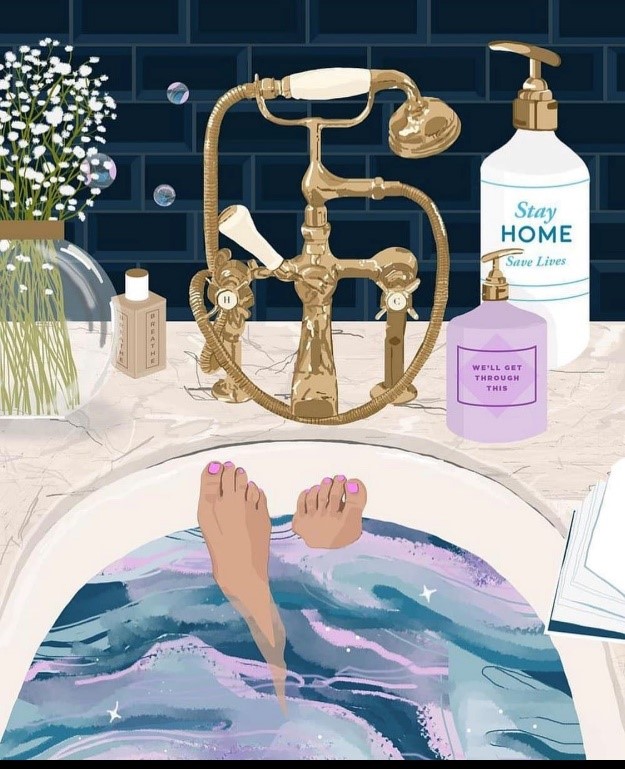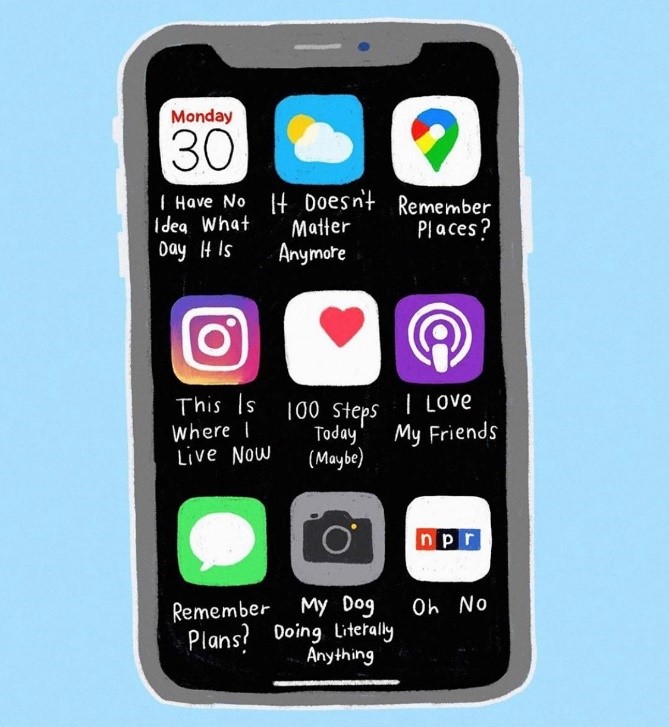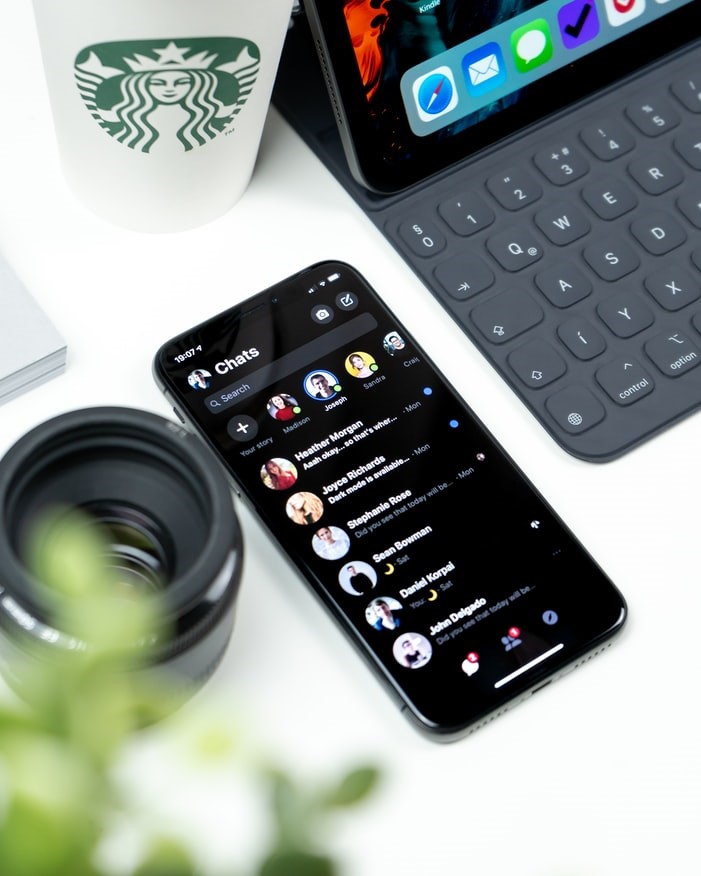


Image 1: CovidArtMuseum by @raquelative on Instagram
Image 2: CovidArtMuseum by @colorsofhoney on Instagram
In times of change, we thrive, we learn new things, and we adopt new ways. Who would have thought that the very same things that pushed us apart, today bring us closer and support us in all matters, from home to work and everything in between.
Technology has long been an enabler, but now more than ever it has become like a solid rock; like a friend we need to help us manage work, relationships, friendships, and hobbies.
A few weeks ago, you might have received an email inviting you to check out the latest in-store fashion collection, or a discount to a cinema projection. The physical world was there, inviting you with wide open arms.
Your favorite clothing shop would have welcomed you with cool, immersive experiences, using neuromarketing tactics from aromatic scents to relaxing music, or smart interactive fitting rooms. Retail brands invested in opening new stores in prime city locations, offering high-tech in-store experiences like interactive mirrors with touch screens to call shop assistants, review catalogues, changing environmental lights to test clothing in different settings, or even allowing a customer to try on different clothes virtually.


Image 3: Covidartmuseum by @artbabygirl on Instagram
Image 4: Covidartmuseum by @ignasy on Instagram
Now, if you are part of a brand’s mailing list, you might receive an invite to an online new product launch event, or a private appointment with your favorite brand shop assistant, or for wine enthusiasts like me, a virtual wine tasting ;-).
Your home delivery app used to be something you used to order some late-night food after an exhausting work day. Now it’s become your main supply channel to everything from your morning Starbucks matcha latte, to your facial mask, aspirin, or that Lindt chocolate you crave on those emotional-roller-coaster days.
The way we absorb content, entertain ourselves, and take care of basic personal needs has also changed. We read more news, we browse constantly for information, we learn on LinkedIn, we entertain ourselves with already-known channels like YouTube, Spotify, and Amazon – but we also started using Zoom for video calls with friends, became creative and started dancing on TikTok, and invited everyone to join our HouseParty.
The YouTube account you had to watch funny content, has now become source of inspiration to help you keep practicing your hobby, or to learn something new at home. How many of us left the gyms, sport centers, and abandoned outdoor activities, opting to buy home equipment and subscribe to an online yoga, HIIT, or gym class?
How many of us started learning a musical instrument, or learned dancing or drawing through other digital channels and applications?
Online grocery shopping became normal; in fact, doing just about anything online became normal!
The new fashion is no longer your weekly change of wardrobe, but the series you watched, the podcast and the app you found, or the funny meme you shared.
Some designers have even gone as far as creating digital clothes; 3D-rendered garments that only exist virtually.
Clothes no longer identify us, but the stories we have to tell of our personal digital experiences do.
Storytelling has picked up. It is now fashionable to tell a cool story based on your virtual discoveries or content you have consumed.
In the business context, we also have seen some major changes. Gone are the early wake-up alarms, catching buses, trains, or spending 40-60 minutes in the car to get to work, where you would have endless meetings, water cooler conversations, answer work emails, maybe check some social media, get lunch with a colleague, etc. Our kitchens, living rooms, bedrooms, and gardens have converted into offices; our gadgets hold the meeting room space.
Our 9-5 working day is gone. As home and office life merged, available time to check social media feeds, read through private e-mails while commuting to office or back home, has disappeared. We are always online and available, with fewer distractions from our physical world. Within days’ time, we turned into constantly plugged-in, connected digital consumers.
Global teams have converted annual business conferences, product launches, and industry-wide conventions to virtual events with the help of webinar, live stream, event planning, communication, and marketing automation technologies.
The consumer as such has changed forever. Our purchasing behaviors, spending patterns, routines, and brand interactions have changed in the blink of an eye.

Picture: Thanks to Charles Deluvio for sharing their work on Unsplash.
We have taken up new ways of learning, working, entertaining ourselves, procuring essentials and non-essentials, connecting with others, and increasing wellness while at home.
Our brand interests depend on how they respond to the COVID-19 current crisis, and what their acts of solidarity and manner of communication are.
Our brand interactions have changed to digital, low-touch activities. We replaced the in-person interactions to fully digital interactions.
Many brands have changed their ecommerce model to serve this new, low-touchpoint approach, offering home delivery, click-and-collect, and curbside pick-up.

Picture: Thanks to Daniel Korpai for sharing their work on Unsplash.
This also implies that the customer journey we used to know from the past has also changed. Now more than ever before, digital experiences are crucial.
We engage with companies through social media, wearables, smart home devices, and connected vehicles.
We have become “professional” shoppers, no longer relying on advertisements or media broadcasts to decide what to buy.
Before we reach a brand’s home page, we check out their Instagram page and Stories; we speak to family and friends, interact in online blogs and vlogs; look at online customer review sites, price comparison websites, Google – and then maybe eventually land on a brand’s website.
A Deloitte study says that there is a correlation between the level of consumer pre-purchase activity and the level of spending.
What does this mean for companies? Can they play a consultative role or interact with the consumer?
Offer the right product at the right time? How can a marketing automation platform support this?
Now more than ever, we want experiences adapted to our needs. We are stuck at home, we have seen that digital works, we have seen that our Instagram pages and Stories are extremely intelligent and offer content which is highly curated – day in and day out – and so we expect, or better said, demand the same from every brand we interact with on every channel.
When we speak about personalized experiences, we are no longer looking for those that are digital only. With quarantine restrictions loosening up, as physical shops begin to open up, we expect that this curated content we were exposed to digitally will also be translated to the in-store experience. For this to happen, a brand needs to know their customer, measure and predict behavior, and adapt the content across all channels.
The demographic profile or e-mail click-and-view behavioral segmentation is no longer enough to entice a consumer.
What is a 360 degree customer profile?
It’s a customer profile that reflects one’s everyday life, including: interactions with friends; social media contacts; social media content; interaction with brand emails – opens, views, when and where these opens happen; your website traffic – which landing pages they review and how long they stay, which products they scroll through, what product information they pay attention to, if they share the product to discuss with friends and family, what their shopping basket value is, and of course, are they purchasing?
What is the lifestyle of your customer? What are their ideologies, favorite brands, and causes they care about? What moves them? What interests them? It is no longer relevant to curate content only around your products, trying to push your unit’s sales.
Today’s digital consumer, especially in post-COVID-19 times, requires meaningful interactions and meaningful content which fits their idea of life and their values and belief system.
Being able to measure, analyze, and extract advanced knowledge about their behavior, operational data (what they do), what they perceive when they interact with your brand, and experiential data (why they do it) is key to being able to run continuously relevant customer journeys across all platforms and consumer touchpoints.
And if we also rely on predictive models based on artificial intelligence and machine learning to predict the behavior of our customers, we can anticipate their needs, offering them the most appropriate experience at all times.
Intelligent marketing automation platforms, now more than ever, show true value to both marketers to meet customer demands; but also to grateful consumers who get to experience seamless relevant customer journeys.
Launching integrated cross-channel marketing campaigns and reacting in real-time to every single consumer is no longer “cool to do,” but a “must” business operation.
Collecting consumer data from all consumer engagement channels – and being able to synthesize it to create a holistic “super-consumer profile” without the need to manually merge data from different sources – is essential to enable AI and machine learning capabilities.
Intelligent marketing automation platforms have learning algorithms to organize this consumer data in real-time and boost the conversation by optimizing the customer journey – sending the right offer at the right time.
To achieve this, tools to study the web browsing behavior of a consumer are vital. Real-time website behavioral tracking enables data-driven personalization. Every single consumer will have a unique website experience based on his or her profile. Product pop-ups, messaging, and colors will be immersive and identical to the consumer profile.
Intelligent marketing automation platforms offer simple, guided workflows to analyze and define audiences based on their actions, purchase history, or CRM profile data – and retarget those audiences, based on the rules you establish.
Brand storytelling is essential now. However, now that the consumer has more disposable time to engage with your stories (and also to follow up with them), “story-doing” has thus become essential, too.
Being locked up at home provided us with a lot of “free time” and has resulted in a 100% digital species with minimal brand touchpoints and maximum brand expectations. Are you ready to serve the post-COVID-19 consumer and their re-invented customer journey?

Picture: Hava Billen with friends, visit art exposition on surrealisms. Quarantine de-escalation phase 1 in Catalunya, Spain.
Marigold: where relationships take root.